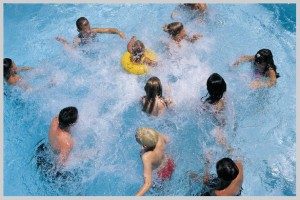The 2010 American Disabilities Act (ADA) guidelines for the Accessible Design for Recreation Facilities were revised and sign into law on September 15, 2010. The law specifies certain elements of design to ensure that individuals with disabilities are able to access and use swimming pools, spas, wading pools, and other aquatic recreation facilities.
Existing facilities that are already in compliance with the 1991 standards are not required to make any changes. All newly constructed or altered facilities throughout the United States must comply with the revised 2010 standards on or after January 31, 2013.

May 18, 2012: The Department of Justice pushed back the compliance deadline from March 15, 2012 to January 31, 2013. See the updated regulations at: http://www.justice.gov/opa/pr/2012/May/12-crt-649.html
ADA Recreation Guidelines and Requirements
ADA Guidelines require compliance by both public and private facilities including pools operated by public park and recreation districts, hotels, motels, fitness/sports clubs, country clubs, high schools/universities, water parks, hospitals, healthcare facilities and homeowners associations (if the facilities are open to the general public).
So does this affect existing Association-governed communities? The answer is yes if the Association’s aquatic facilities are ever made available to people or organizations outside the Association membership.

Examples include renting out the pool area for private or community events, like parties, weddings, or fundraisers. If the Association’s pool area is “open to the general public” in these ways, then any Association that does “accessibility-related” alterations (i.e., stair, deck, or gate system replacements) to their aquatic recreation facilities would need to comply with ADA standards. A Board of Directors that has questions or concerns about whether their Association is subject to these revised standards would be wise to consult an attorney that specializes in ADA compliance issues.
The regulation defines five (5) permitted means of entry to the pool which include lifts, sloped entries, transfer walls, transfer systems, and accessible pool stairs. The regulation provides detailed specifications for the pool lifts and slopes. Specifics are detailed in Section 1009 and Chapter 2, section 242 of the 2010 ADA Standards for Accessible Design.
ADA Swimming Pool Requirements
Any swimming pool with less than 300 linear feet (91 meters) of pool wall must provide one (1) means of access either by sloped entry or a pool lift. Any pool with more than 300 linear feet (91 meters) of pool wall must provide two (2) means of access, which can be any of the 5 permitted means of entry complying with all sections of 1009
ADA Wading Pool Requirements
At least one accessible means of entry shall be provided for wading pools. Accessible means of entry shall comply with sloped entries complying with 1009.3.
ADA Spa Requirements
At least one accessible means of entry shall be provided for spas. Accessible means of entry shall comply with swimming pool lifts complying with1009.2; transfer walls complying with 1009.4; or transfer systems complying with 1009.5
See Sections 242 and 1009 of the 2010 ADA Standards for Accessible Design for detailed information. For information about how it affects your facilities please contact your pool vendor.
